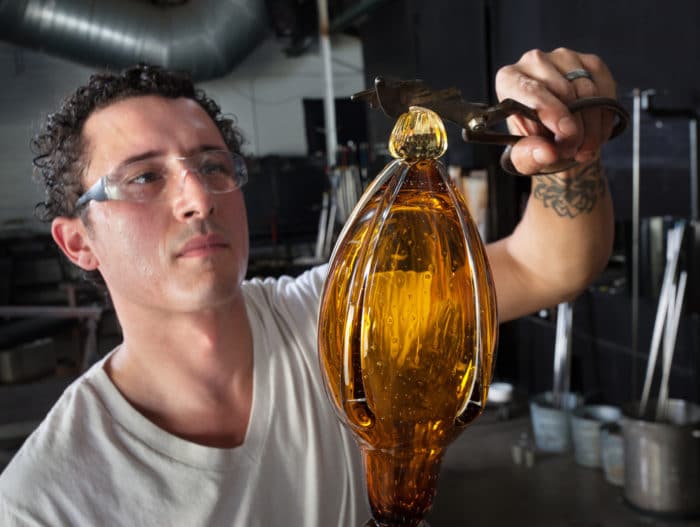Why We Love It
-
$35,710Potential Avg. Salary
-
Creativity FocusedCareer Attribute
-
Skill-Based WorkCareer Attribute
-
Work With Your HandsCareer Attribute
The art of glass blowing requires finesse and technical expertise in shaping and molding blobs of glass into different shapes such as handcrafted giftware, stemware, glasses, jewellery, etc. This is achieved by using three separate apparatuses or divisions of a furnace. A glass blower places molten glass on the end of a long metal pipe and blowing air into one side, causing an air bubble in the centre of the blob which is then crafted into the desired design.
Recommended Schools
What is a Glass Blower?
Glass blowers, also called glassmiths or gaffers, can have a wide range of duties such as those listed below:
- Design, produce and finish a variety of decorative pieces which includes windows, mirrors, ornaments, tableware and other art pieces.
- Form glass into rough shapes using molten glass (from a furnace) and a blowing iron.
- Attend trainings and workshops to keep up to date on the latest advances in the industry whether it is technological, scientific and innovative – learning new techniques to improve your design knowledge.
- Research and monitor the worldwide glass market to ensure products are current, in demand and reasonably priced.
Day in the life
A professional glass blower’s day begins with combining ingredients needed for molten glass in a heavy metal pot. The ingredients are then heated to high temperatures in a furnace or kiln. The glass blower uses a long metal pipe to rotate a blob of molten glass into a certain shape, blowing short puffs of air from the other end.
Depending on the desired look of the finished piece, a glass blower has to use other tools and equipment for shaping the glass, such as calipers and paddles to stretch and pull the molten glass into the required look. After the design is created, the glass blower’s job also involves making sure that cooling takes place properly to prevent the glass from shattering.
Work schedule and typical hours
Salaried glass blowers that work in factory settings will have fixed hours and may have to work in shifts. However, there are no set hours for self-employed designers who work around client requests and individual projects. If there are tight deadlines, working during the evenings or over weekends might be necessary. Trainees or ‘gatherers’ may be expected to start early in the morning, but finish early afternoon.
Growth of the job
The demand for glass blowers is expected to increase, with an expected 17,250 new jobs to be filled by 2018. This represents an annual increase of 6.69 percent over the next few years. Careers cover a wide spectrum of individuals and can include teaching or artistic work. Salaries depend based on the skill of the glass blower, from the average hobbyist to the master craftsman. While some glass blowers may make low incomes, creative and talented individuals can tap into a very lucrative glass blowing career.
Typical employers
The majority of glass blowing professionals work independently as self-employed artists, designers or makers. Selling handmade glass products is usually done via craft fairs, exhibitions, galleries or arts centre gift shops. Such artisans create customized pieces and sell them for specified prices based on complexity of the work and uniqueness.
Glass blowers that work in studios, glass factories and glass museums may specialise in different areas such as stained glass, engraving, etc. While department stores usually have collaborations with larger design brands, some may sell exclusive ranges of independent artists. Online shopping has widened the potential client base for glass blowers, as most can create online boutiques with original designs for purchase.
Recommended Schools
How To Become a Glass Blower
It is not easy to start off one’s glass blowing career as it is a very niche trade. One has to acquire specialized knowledge and only certain educational institutions like universities or trade schools offer formal training and degree certificates in glass blowing techniques. Glass blowing is also taught at certain art studios and art galleries across the U.S. Non-credit classes or workshops in glass blowing are also a good place to start mastering the basics.
It is a demanding profession and requires a specific skill set. A glass blower must have high levels of patience, heat tolerance, and willingness to work in potentially dangerous conditions. Most glass blowers start their career by learning through an apprenticeship and acquiring hands on experience to hone their skills. An apprentice’s job is to assist the master glass blower with any support tasks and learn new methodologies and tools for glass blowing.
Glass Blower Salary Data
We’ve provided you the following to learn more about this career. The salary and growth data on this page comes from recently published Bureau of Labor Statistics data while the recommendations and editorial content are based on our research.
National Anual Salary
Low Range
$23,010Average
$35,710High Range
$59,750National Hourly Wage
Low Range
$11/hrAverage
$17/hrHigh Range
$29/hrHow do Glass Blower salaries stack up to other jobs across the country? Based on the latest jobs data nationwide, Glass Blower's can make an average annual salary of $35,710, or $17 per hour. This makes it an Above Average Salary. On the lower end, they can make $23,010 or $11 per hour, perhaps when just starting out or based on the state you live in.
Salary Rankings And Facts
#608 Nationally for All Careers
Highest Education Among Glass Blowers
- 1.9% Doctorate
- 12% Masters
- 45% Bachelors
- 9% Associates
- 18.4% College
- 10.7% High School
- 3% Less than High School
Job Growth Projections and Forecast
2014 Total Jobs
10,6002024 Est. Jobs
10,600Job Growth Rate
---Est. New Jobs
---How does Glass Blower job growth stack up to other jobs across the country? By 2024, there will be a change of --- jobs for a total of 10,600 people employed in the career nationwide. This is a --- change in growth over the next ten years, giving the career a growth rate nationwide of Below Average.
Growth Rankings And Facts
#594 Nationally for All Careers
What Companies Employ The Most Glass Blowers
| Industry | Current Jobs | New Jobs Needed | % Increase |
|---|---|---|---|
| Self-employed workers | 5,900 | 100 | 0% |
| Independent artists, writers, and performers | 1,700 | 100 | 0% |
| Clay product and refractory manufacturing | 400 | -100 | 0% |













